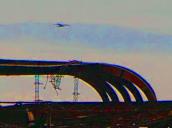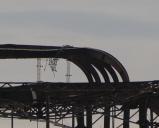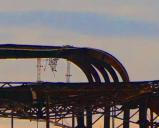
-
Focus pull feature should have an option to drive focus motor using joystick. Speed1 - up/down, speed2 left/right.
-
@Vesku - that would be a sweet function!
-
@driftwood - Hello Nick, could you please tell us more about the Pana Leica 12-60 f 2.8-4 ? when is the f 4 coming , at 20mm,30mm 40mm ?
thank you
-
Hi, I'm having problems playing back or importing in Premiere CC (latest) the original 6K file Driftwood provided. What is missing on my system? Premiere warned me it had to install the Hevc codec to import the video, I clicked ok, but still doesn't work
-
@davjd, I have the same problem as you. :)
-
I think everyone is having issues with the footage, however transcoding it to something else (ProRes) fixes it for me.
-
-
Is this caused by h.265 compression or Potplayer de-compression and frame saving. I added saturation 80% in Photoshop. Some funny dithering comes visible in 6k photo sample.

 zoom1.jpg761 x 566 - 164K
zoom1.jpg761 x 566 - 164K -
@heradicattor "even at -3 is still over sharpened and thats is not good in any way"
It's soft like hell not overshared but full of compression artifacts. I think it needs at least 50% if not 100% more bit rate for the extracted images to look good.
-
I've been using a Ninja Assassin, and I'm done with internal codecs. I like what I've seen about GH5 the sensor so far, but not ever going back to internal codecs on a DSLR.
-
Here are crops from your 16bit 6k frames converted to 8bit JPG. Looks much better than my versions extracted with Potplayer. I see no dithering.

 6kphoto-ok.jpg601 x 483 - 161K
6kphoto-ok.jpg601 x 483 - 161K
 6kphoto-ok-sat80.jpg601 x 483 - 285K
6kphoto-ok-sat80.jpg601 x 483 - 285K -
@Ralph_B these are VFR codecs, the bitrate will change based on the amount of info, you basically set the quality and the file size will float accordingly, so it doesn't change anything. It's like saying that 24p will be better quality because it has 20% less frames than 30p but it's not CBR. And the compression is not making the file fall apart, it's not like it would gain much by just a bit more data. It would still be a niche thing that Panasonic could solve with just crop markings for cheaper, there is not much upside on that, even more because with crop markings you still have extra room in post for fixing stuff.
-
@chipxsd it would need that much to do a proper 10-bit 422 but if Panasonic will bring 400Mbps mid-2017, they could very well make the hi-res anamorphic around 300Mbps 10-bit 422.
-
I've played with a RED before (when scarlet came out) and I was just blown away with how much control you have over the raw footage, practically the same as if you'd import an .rw2 file into your image editing software, but for video. I don't recall what redcode format I had used, bitrate, bit depth or the chroma subsampling, non of that stuff, I didn't even know what those things meant back then... but I had really hoped we would someday see this type of process with our mirrorless cameras, since that would eliminate the use of all these color profiles (vlog and whatnots), since it wouldn't be burned into the footage, these things could always be applied later in the process chain.
I doubt that having the 10-bit 422 gets us any closer to the process I had in mind though, but still it's a huge improvement.
-
Hi, this is a frame grab done from the 6K photo stream. It was processed through Sony Vegas Pro exclusively. Some sharpening (perhaps a bit much) and brightness/contrast adjustments made. This version of Sony Vegas Pro can only output a max of 4096 pixels, so the image is a 4096x3456 crop of the original 5184x3456. The EXIF is also included in the picture.
https://4.img-dpreview.com/files/p/E~forums/58949973/700af866f15f473797b5b32043431fb2
The original stream was definitely undersharpened, if your goal is to just extract a frame and keep it as a still image with no further processing. But a lot of additional detail shows through if you add sharpening. If you're doing 6K Photo with the goal of having an 18MP photo, it might be better to turn up sharpening and contrast in camera. Just IMO.
-
I also wanted to add a couple other things. From looking at the 6K Photo stream, I would say it packs in an incredible amount of detail and probably close to rivaling the jpeg/RAW performance. Definitely far better than the past 4K modes on Panasonic cameras. This is actually usable for pro quality stills performance.
The 6K photo stream can also be used to shoot 5K video (5120x2880) video with 1:1 pixels (i.e. no scaling, using the 3:2 6K Photo mode) or 6K anamorphic video (using the 4:3 6K Photo mode). You don't have to wait for Panasonic to release an anamorphic video mode to use this now.
Also, you can do temporal NR on these 6K streams to reduce noise BETTER than you can with RAW/jpeg. Neat Video will work on this to actually extract more detail than you could with individual stills, and you can improve the SNR markedly. You can turn off the spatial NR entirely and still get very good NR. The high ISO performance using the 6K photo mode should be REALLY good if you use temporal NR or image stacking.
Finally, I posted a link to the processed image above that didn't include the EXIF data. Here's the processed image with EXIF included.
https://3.img-dpreview.com/files/p/E~forums/58950941/d999de6dc7034e46abfcc332e703a153
Again, it's a 4096x3456 crop of the original 5184x3456 image, so some of the image on the horizontal was cropped out.
-
Ill be doing GH5 tests with Atomos Shogun Inferno @sian next week. I got the Atomos today (beta fw for 60p GH5). At the moment GH5s in such incredible short supply - probably 5 in Europe! That everyone is after a piece of pie. My tests were done over a couple of days New Year then it went back. Ill have it again next week so I can thoroughly answer questions.
My opinion so far. Its a really good camera for the price, doing some incredible things. You can't expect it all but it comes real close! In fact after giving it back after only 2 days use, I felt at a loss. I really did.
For now, you can appreciate that none of my tests were in-depth, so Im sorry if you are frustrated. But I will get round to answering questions. Do you know Im getting hundreds of emails every day in my INBOX... its quite taxing when you've got to work as well.
-
Can V-Log L be used in the 5K/6K mode?
-
AF performance. - does it still do the focus affirmation 'rock' after focussing? - I suggested to skip this 'focus rocking' and only rely on DFD at the end of a focus shift in video mode.
-
I suggested to skip this 'focus rocking' and only rely on DFD at the end of a focus shift in video mode.
DFD can't replace contrast autofocus. All it can do is to get some idea on how far optimum focus are, so you can ramp or slow down lens focus speed.
-
Panasonic claims that the GH5 will focus in video as well as anything else on the market. They claim to have greatly reduced or eliminated focus "breathing"
Go to 7:15 in the video.
The reason for this is that they've upgraded to a 480Hz system and dramatically increased the number of focus changes that can happen per second. They've implemented more advanced subject/motion tracking capabilities.
Basically, the video AF system is now as good as the stills AF system. You can expect massive improvements. This is one of the highlight features of the GH5
-
The reason for this is that they've upgraded to a 480Hz system and dramatically increased the number of focus changes that can happen per second. They've implemented more advanced subject/motion tracking capabilities.
My understanding is that 480Hz is special mode working before any video shooting happens, same as on previous bodies. Also this mode does not work with most Panasonic lenses (because it makes no sense for them).
Basically, the video AF system is now as good as the stills AF system. You can expect massive improvements
Nope. As stills AF works different from video and in video your sensor mode restrict AF performance.
I fully understand Panasonic marketing who want to prize their AF, but contrast AF has physical limits no marketing can overcome.
-
Regarding the contrast AF, I'm not really sure you can reach the conclusions you have with no reviews to back it up. I don't really recall Panasonic ever talking about video AF before, much less hyping it up like they are.
Here's another video talking about it.
The issue before was that even though they were sampling the sensor at 240 fps, the actual corrections being made were only at 6 fps. The new system is capable of up to 480 actual corrections per second. The lens doesn't actually have to be able to handle 480 corrections per second to make use of the new DFD tech. It only has to be able to handle more than 6. Most modern Panasonic lenses are actually speed demons. Maybe not 480fps fast, but still incredibly fast. I believe many of them going back several years can handle 240. Will it really make any difference if the lens itself can AF at 240 or 480? I doubt it. I think what matters more is how fast the sensor can sample.
Also, I'm not convinced it was the sensor mode in video on prior cameras that was the problem. It could have just been a processing power issue. It was well known since the GH4 was released that 4k was a lot slower than 1080p in focusing. Most people had no problem with 1080p on Panasonic cameras.
The bottom line is I expect a massive improvement in video AF and a reasonable improvement in stills AF, which was already excellent to begin with.
Time will tell. :)
-
Most important to me is ISO usability, highlights performance, Auto-focus in video (I use this more and more) IBIS with lenses without shake reduction, battery time, slow motion quality, also how reliable is focus peaking working. And what is the biggest caveat with the camera you have had so far.
Thanks for helping @driftwood
Howdy, Stranger!
It looks like you're new here. If you want to get involved, click one of these buttons!
Categories
- Topics List23,995
- Blog5,725
- General and News1,357
- Hacks and Patches1,153
- ↳ Top Settings33
- ↳ Beginners256
- ↳ Archives402
- ↳ Hacks News and Development56
- Cameras2,368
- ↳ Panasonic995
- ↳ Canon118
- ↳ Sony156
- ↳ Nikon96
- ↳ Pentax and Samsung70
- ↳ Olympus and Fujifilm102
- ↳ Compacts and Camcorders300
- ↳ Smartphones for video97
- ↳ Pro Video Cameras191
- ↳ BlackMagic and other raw cameras116
- Skill1,960
- ↳ Business and distribution66
- ↳ Preparation, scripts and legal38
- ↳ Art149
- ↳ Import, Convert, Exporting291
- ↳ Editors191
- ↳ Effects and stunts115
- ↳ Color grading197
- ↳ Sound and Music280
- ↳ Lighting96
- ↳ Software and storage tips266
- Gear5,420
- ↳ Filters, Adapters, Matte boxes344
- ↳ Lenses1,582
- ↳ Follow focus and gears93
- ↳ Sound499
- ↳ Lighting gear314
- ↳ Camera movement230
- ↳ Gimbals and copters302
- ↳ Rigs and related stuff273
- ↳ Power solutions83
- ↳ Monitors and viewfinders340
- ↳ Tripods and fluid heads139
- ↳ Storage286
- ↳ Computers and studio gear560
- ↳ VR and 3D248
- Showcase1,859
- Marketplace2,834
- Offtopic1,319












